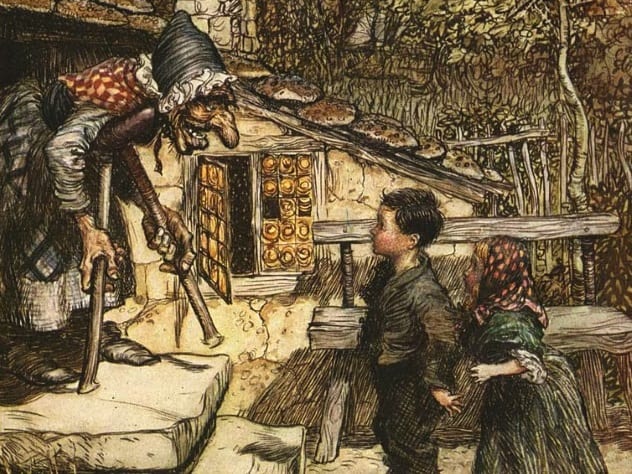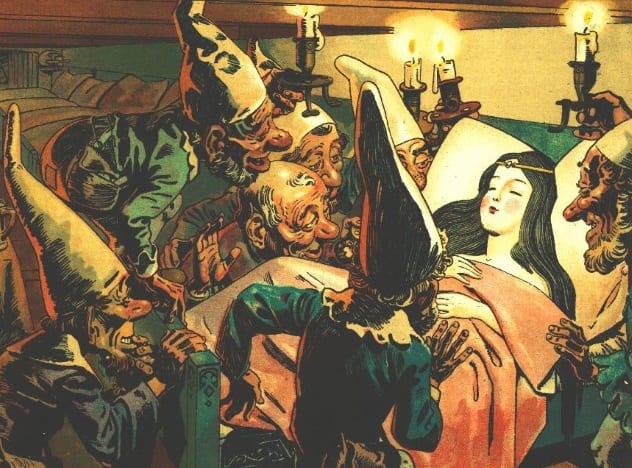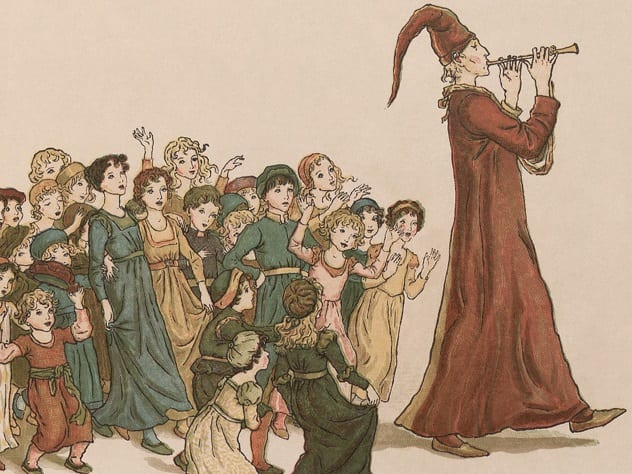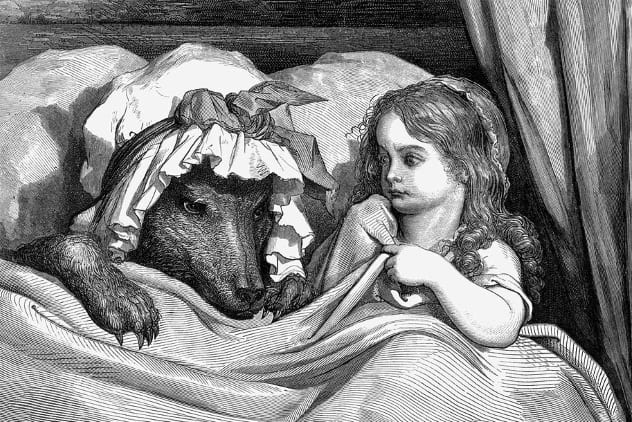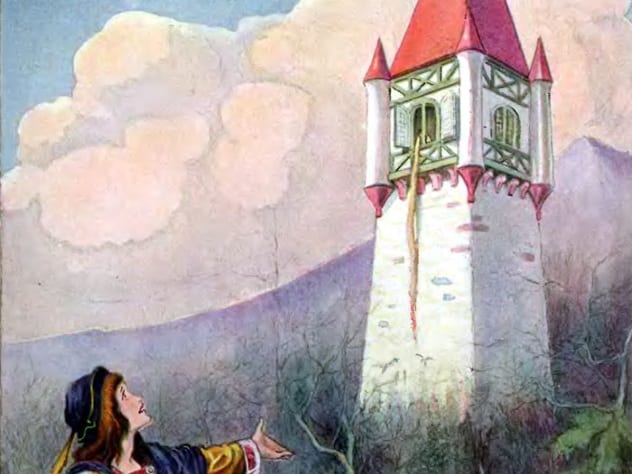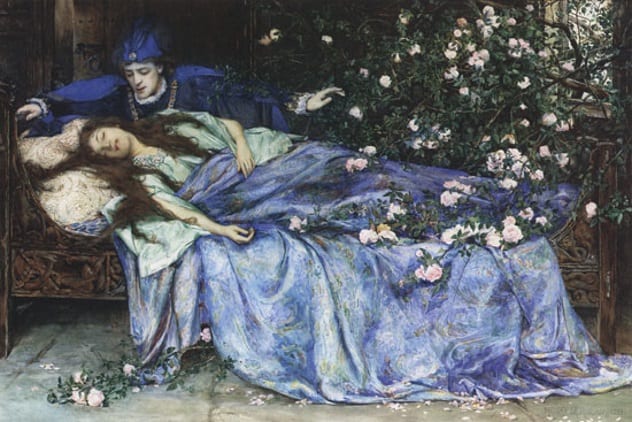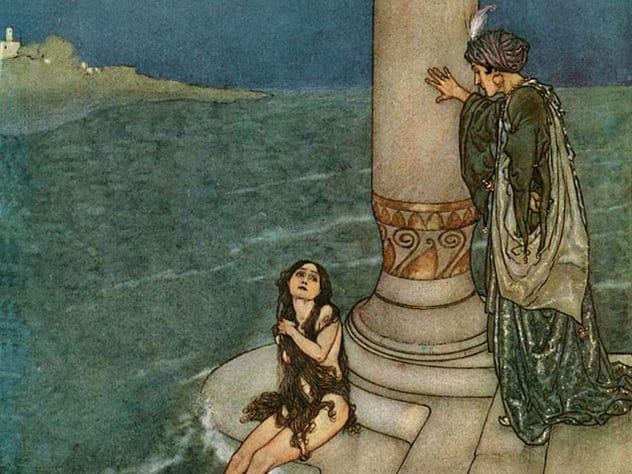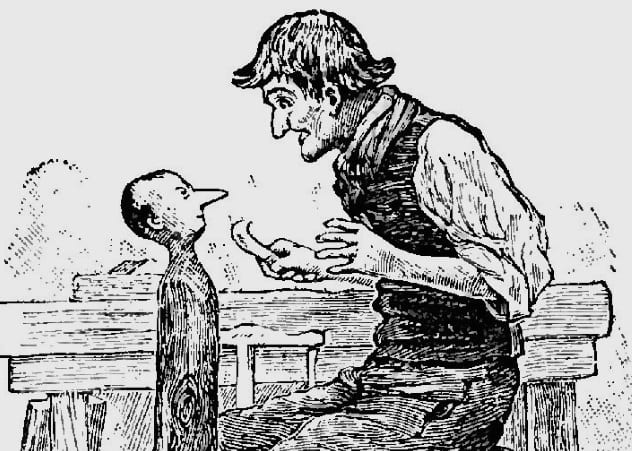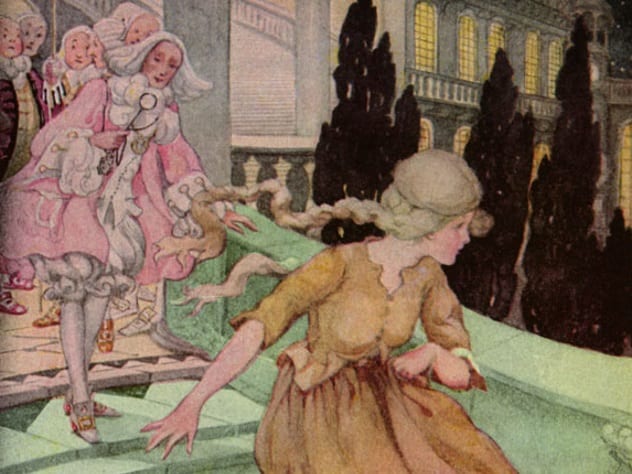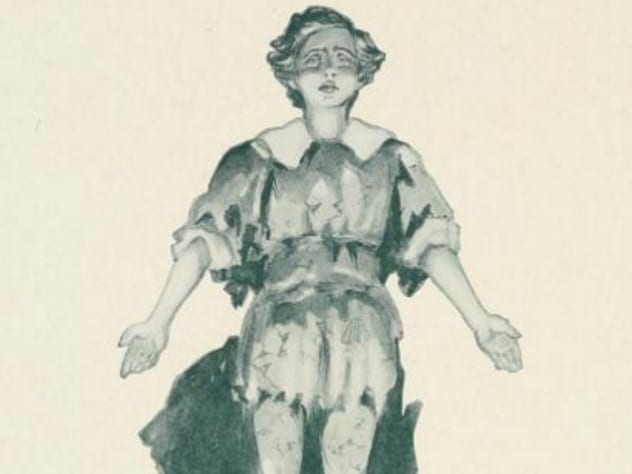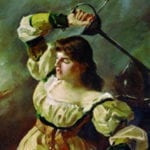But while the magic may never cease to glisten, these interpretations have long been brushed over through the use of film and art. Song, dance, and fairy dust have covered the deep, dark elements of ancient tales. What’s most interesting is to explore such stories through the mindset of their original authors while examining the often disturbing elements hidden through youth.
10 ‘Hansel And Gretel’
The tale of Hansel and Gretel remains to this day one of the most twisted stories crafted by the Brothers Grimm, Jacob and Wilhelm. While being melancholy in its dim setting against the backdrops of a German village ravaged by a hideous famine, it also carries the prominent theme of child abduction. As recorded, the tale follows brother and sister Hansel and Gretel, who are loved greatly by their father but loathed harshly, and rather predictably, by their wicked stepmother. Impoverished, the stepmother decides that having two extra mouths to feed doesn’t quite work for her, therefore persuading her husband to take his children into the woods and abandon them. The father does so, leaving the two youngsters in the middle of a dark forest. Love was clearly thin back then. And so, we follow Hansel scoffing away on bread, leaving crumbs (or pebbles) along the path until the siblings stumble across a “gingerbread” cottage—a haven of chocolatey dreams. To cut a long story short, the house is owned by an overfamiliar witch who forces Gretel into slavery and occasionally prods Hansel with a stick to see if he’s plump enough to eat. As the hag prepares the oven for dinnertime, Gretel pushes her in and locks the door. Pretty grim, don’t you think? Well, it gets weirder—the conclusion of the story has the siblings following the trail of breadcrumbs they left behind to eventually rediscover their father. He’s dumped their stepmother and wants them back. All is forgiven. Second chances are easy to come by in a fairy tale world.
9 ‘Snow White’
Dark forests, poisoned apples, and problems with mom. ‘Snow White’ is one of the best-known, if not the most popular, fairy tales. It tells the story of a young princess with “skin as white as snow, lips as red as blood, and hair as black as ebony.” (Guess what her name is.) The girl grows into a beautiful young woman in a rich kingdom, though her deceased mother’s place has been taken by a “wicked stepmother.” But this isn’t any old wicked stepmother; she’s also an evil sorceress obsessed with her appearance. After consulting her magic mirror, the queen discovers that Snow White is “the fairest of them all.” Skip forward, and we’ve got a failed assassination plot, Snow moving in with seven dwarfs in the wood, and the evil queen coming up with new schemes to be rid of her stepdaughter. In the end, she poisons Snow White with an apple, but the miracle of the piece is a magic kiss from the lovely Prince Charming. (Isn’t that what all the princes are called?) Let’s put this into perspective: A vain woman reaching her forties decides the best way of boosting her ego is to murder her stepdaughter? Not by blade, not by hand, but by apple. And even that doesn’t work. The power of true love prevails.
8 ‘The Pied Piper Of Hamelin’
This is the one that makes my skin crawl. It tells the tale of another German village plagued with problems, most specifically a rat infestation. One day, an eccentric piper turns up, claiming he can cure the town. Playing a tune, he lures the rats into a river and drowns every last one. But when it’s time to pay the piper, the townsfolk refuse. Angered, the piper returns and places all the town’s children under a spell, ordering them to follow him out of the village and disappear forever. Now, here’s the dark bit: There are several versions of the ending. One has the piper taking the children over the hills and through a portal into a beautiful new land where they stay together forever. Another washed-down version has him return the children after installments of his money are paid. But the most disturbing of all is a version where the piper orders the children to walk into the river, therefore drowning all of them just as he did the rats. Every child in the village is deceased, with the exception of a single deaf girl.
7 ‘Little Red Riding Hood’
Who’s afraid of the Big Bad Wolf? It may be a question more prominent now than ever before. This story has Little Red traveling through the dark forest (there are a lot of dark forests) to reach her grandmother’s house. Along the way, she’s stalked by a wolf. Now, let’s talk about the wolf. Predatory, sneaky, and bordering along being inappropriate, his approach toward Little Red is incredibly creepy, which has led people to believe that the Big Bad Wolf is a caricature of sexual predators.[1] If that isn’t grim enough for you, how about the fact that after the wolf consumes both Little Red and her grandmother, a woodcutter comes along and hacks it to death, freeing both? Maybe this is why we’re taught not to talk to strangers.
6 ‘Rapunzel’
A lot of these fairy tales seem to be based around bad parenting, and what better one to explore that than “Rapunzel?” The story begins with a handsome prince (yeah, another one) finding a tower inhabited by a beautiful maiden with really long hair. They make a pretty couple, so the prince makes frequent visits to his “girlfriend” until he discovers she’s being guarded by a cruel, overprotective hag. It transpires that the girl was taken from her family after the hag caught her father stealing rampions from the garden. She strikes a deal—unlimited rampions for the pregnant wife in exchange for their firstborn daughter. Fast-forward a number of years, and Rapunzel is locked in that tower all alone. One evening, the prince climbs the tower with help from Rapunzel’s golden locks and comes face-to-face with the witch. He’s thrown from the tower and into a thorn bush, blinding him. Rapunzel is cast out by her adoptive mother and has her hair forcefully cut. But at least in the end they end up together! A happy ending, of sorts.
5 Sleeping Beauty
Time for a bit of deja vu. Sleeping Beauty has many different narratives. The first published version was by an Italian poet named Giambattista Basile, later adapted by Frenchman Charles Perrault. Then it was collected by the Brothers Grimm.[2] We’ll go with Perrault’s version; Giambattista’s starts sounding like an entirely separate tale. The king and queen of a faraway kingdom invite all the fairies in the land to attend the christening of their daughter. One, however, is excluded. An “old fairy” arrives and, angered that she was not invited, curses the child to die by a prick on the finger via spinning wheel. Another fairy, kinder and more gracious, gives clause for the curse to be broken after true love’s kiss. The king tries to burn every spinning wheel in the kingdom, but that does not stop his daughter from falling into a coma for 100 years. Eventually, a prince arrives and awakens her. Given that 100 years have passed, though, this surely means the princess has no family. No friends. No one to care for her except for this random man in her bedroom.
4 ‘The Little Mermaid’
Now we move into the realm of Hans Christian Andersen. Unlike its 1989 Disney adaptation, this story runs darker—probably because there are no songs. In this tale, mermaids are permitted to swim above the surface on their 15th birthday. The titular mermaid (let’s call her “Ariel” for clarity) spots the dashing Prince Eric. Visiting her grandmother, Ariel is told that while humans die and live on in “eternal heaven,” mermaids fizzle and evaporate into foam without any life after death. (It’s uncertain how this influences afterlife theology.) Ariel visits a sea witch and is granted the gift of legs to walk the human surface, with the condition that she give up her voice and . . . her tongue. On top of this (prepare yourself), she will be able to walk and dance, but she suffers terrible pain as if “walking on knives,” which results in her feet bleeding heavily. Her trip to the surface takes a horrible turn when the prince falls in love with another woman after a case of mistaken identity, resulting in the Little Mermaid killing herself and dissolving into foam.
3 The Adventures Of Pinocchio
To this day, I find the 1940 film Pinocchio unbearable to watch. The metamorphosis of happy children into frightened donkeys as well as a young wooden boy to human still doesn’t quite sit well in my mind. But the original Pinocchio is set in Italy. A carpenter chops up a pine tree and becomes terrified when the wood speaks to him. Terrified, he gives it away to his poor neighbor, Geppetto. The wood is carved into a model of a boy and is named Pinocchio. The child, however, has a rotten attitude and is incredibly mischievous. Aside from kicking Geppetto, he runs off into town and has his creator imprisoned for apparent mistreatment. Returning home, Pinocchio is met by a talking cricket who tries to teach him the importance of kindness. Instead of taking these words of wisdom, Pinocchio throws a hammer at him. The story moves forward through the boy’s many adventures—from being kidnapped by a fox and cat to being sold off to a puppet master. After finally learning the importance of being good, he transforms into a human.
2 ‘Cinderella’
In what was originally known as “The Little Glass Slipper,” there’s less “bippity boppity boo” and more spine-tingling bloodshed. Cinderella’s mother dies from plague-related disease. While she visits the grave every year, Cinderella is cautious of her father’s new wife, a vain, pompous woman with two daughters. All three are intentionally wicked. Cinders is put to work in the kitchens and starts performing more like the house servant than the daughter of this rich baron. While her father is aware of said activities, he never seems to speak out in favor of his only daughter—there is a serious parent problem in these tales. Instead of a Fairy Godmother dressed in blue, there is a tree which belonged to Cinderella’s mother. Whenever she visits, she wishes for something and receives it. When a ball is held by the kingdom’s prince, Cinderella asks to attend in a beautiful ballgown and, lo and behold, receives an elegant gown with glass slippers. After dancing with the prince, Cindererlla’s clothes transform back into the attire of a scullery maid, and she returns home. When the prince searches for the fair maiden, he demands that all women in the town offer up their feet to try one of the slippers on. The wicked stepmother comes to realize that her daughters’ feet are way too big . . . so she cuts off the heel from one and the little toe of another. Grim.
1 Peter Pan
J.M. Barrie’s legendary chronicles of the boy who wouldn’t grow up chart the stories and adventures of the Lost Boys as well as Wendy Darling and her two brothers, John and Michael. While we all know the film, the plays, and the cutthroats who try to thwart Pan’s fun, little is known about the strange relationships formed between the characters. For one, have you ever considered the horribly malicious bond between Peter and Captain Hook? A grown man, clearly depressed and an alcoholic, has a disturbingly vicious relationship with a teenage boy—or at least a man stuck in the body of a teen. While Hook consistently tries to slaughter Peter in front of his crew, in some deluded act of heroism, there is also a case for the captain wanting to keep the boy alive. Without Peter Pan, what would Hook be? Maybe along the path, hatred has evolved into love between the two. And what about Peter and Wendy? Having gallivanted away from foggy London direct to paradise, Wendy is described as “nearly a woman,” giving clarity to the theory that she’s in the middle stages of her development into adulthood. Peter, being adventurous and cocky, is often thought to be flirting with her rather than expressing his excitement for having new friends. Meanwhile, Wendy is falling in love with Pan. When she confronts him with her feelings, Peter instead clarifies that he sees her as a motherly figure—the mother he never had. Weird. It’s a hard shove into the friend zone. Will Ferris is a writer and actor. Previously, he has written and directed the short films Hamlet’s Grief, Chicken Head, and most recently Facade, a psychological drama based upon the #MeToo movement. LinkedIn: https://www.linkedin.com/in/will-ferris-b187b2172/
